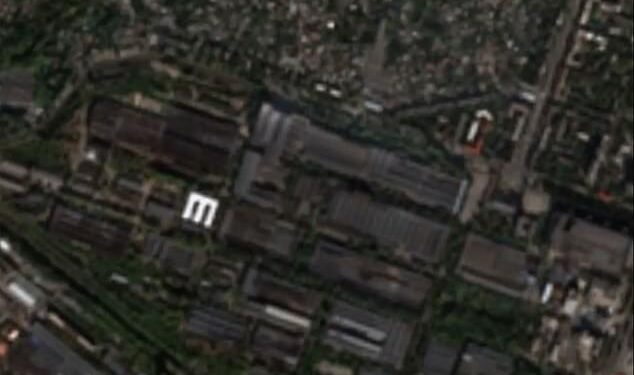Vladimir Putin‘s new ‘wonder-weapon’ caused little damage when he unleashed it on Ukraine, satellite pictures show, despite Russian claims that a defence plant in Dnipro was ‘erased to dust’.
Furious Russian pro-war military pundits are questioning if they have been misled by Putin’s boastful claims over the ‘unstoppable’ Oreshnik.
Dramatic footage showed the weapon releasing six separate warheads during an attack on Yuzhmash plant, also known as Pivdenmash.
Putin claims the missile is ‘unstoppable’ by Western and Ukrainian air defences, and has vowed to increase production of the weapon following Thursday’s launch.
The despot added that the new weapon travelled at 10 times the speed of sound, rendering Ukrainian air defences powerless to shoot it down.
Russian sources said the range was 3,100 miles, with defence officials pointing out that this would allow it to strike anywhere in Europe and the west coast of the United States.
Russian accounts suggested that the Dnipro defence plant had been ‘completely destroyed’ and a ‘black hole’ had formed at the site of the attack.
But the Kyiv Post reported: ‘The images do not support the Russian claims that the plant was “erased to dust”.’

BEFORE: The site of the facility in Dnipro which Putin’s forces targeted with their new Oreshnik missile

AFTER: Satellite images appear to show limited damage to the facility following Thursday’s strike

Pictures show Putin’s new Oreshnik hypersonic super-weapon attacking a defence plant in Dnipro, Ukraine on 21 November 2024


Security camera footage out of the central-eastern city of Dnipro showed several projectiles streaking in and detonating in a series of violent, fiery explosions
Russian war blogger Romanov Light complained: ‘Satellite images of Yuzhmash have emerged following a strike by Oreshnik.
‘The workshops remain intact. Nothing has been ‘reduced to dust’.
‘However, it seems the private residential area above sustained some damage.’
Putin said: ‘Modern air defence systems cannot intercept such missiles. That’s impossible… As of today, there are no means of counteracting such a weapon.’
The hypersonic missile was reported to be able to hit Britain 20 minutes after being launched.
Putin said the non-nuclear Mach 10 hypersonic strike on Dnipro was a test, and the launch was a ‘success’.
The Oreshnik was unleashed in response to the use of US and British missiles by Ukraine to strike Russian territory, he said, referring to ATACMS and Storm Shadow.
Putin alleged that US and UK servicemen were behind the targeting of the precision and damaging attacks.
‘Experts are well aware, and the Russian side has repeatedly emphasised this, that it is impossible to use such weapons without the direct involvement of military specialists from the countries producing such weapons ,’ said Putin.

Parts of a ballistic missile, which Russia used in a strike towards Dnipro city last week, are displayed, amid Russia’s attack on Ukraine, at an undisclosed location in Ukraine
In revenge ‘on the territory of Ukraine, in the city of [Dnipro], one of the largest and well-known industrial complexes from Soviet times, which even today produces missile equipment and other weapons, was hit….
‘I repeat, we are conducting live tests of the Oreshnik missile system in response to the aggressive actions of NATO countries against.’
Some Russian sources claim the goal was to demonstrate the power of the weapon, and show its accuracy and speed.
Others said that the Oreshnik is supposed to cause damage underground which may not be visible on the surface.
Russian forces staged their largest ever drone attack on Ukraine overnight, cutting power to much of the western region of Ternopil and damaging residential buildings in Kyiv region, Ukraine’s officials said on Tuesday.
Intensified nightly drone attacks on Ukrainian cities are coinciding with a major push by Russia along frontlines in Ukraine’s east, where Russian forces have made some of the largest monthly territorial gains since 2022.
Of 188 drones used overnight, Ukraine shot down 76 and lost track of 96, likely due to active electronic warfare, the air force said. Five drones headed towards Belarus.
‘The enemy launched a record number of Shahed attack UAVs and unidentified drones …,’ it said. Russia uses cheaply-produced ‘suicide’ drones and low-cost ‘decoy’ drones, which tie up Ukrainian air defences.
‘Unfortunately, there were hits to critical infrastructure facilities, and private and apartment buildings were damaged in several regions due to the massive drone attack,’ an air force statement said, adding that no casualties had been reported.

This is the moment missiles believed to be British Storm Shadow missiles struck inside Russia

As aerial warfare in the conflict intensifies, a top NATO official yesterday warned that Russia’s ground forces are expanding.
The Chair of NATO’s Military Committee, Dutch Admiral Rob Bauer said Moscow’s land forces are bigger now than when the full-scale invasion of Ukraine was launched in February 2022
But, ‘the quality of those forces has gone down,’ he said, referencing the state of the force’s equipment and the level of training of its soldiers.
‘At the moment, the Russians are not the same threat as in February 2022, so we have a bit of time to prepare ourselves,’ he said, adding that this meant ramping up investments into the defence industry.
NATO is expected to hold emergency talks with Kyiv today to discuss the escalation of the conflict, which has seen some 10,000 North Korean troops deployed to support Russian forces.
Soldiers sent by Pyongyang are believed to be in Russia’s Kursk region, which is partly occupied by Ukraine, and will be ready to enter combat inside Ukraine ‘soon’, according to Lloyd Austin, the US defence secretary.
Meanwhile Britain has urged Kyiv’s allies to continue to support its fight against Russia, with foreign minister David Lammy today telling G7 countries to stand with, and equip, Ukraine for as long as it needs.







